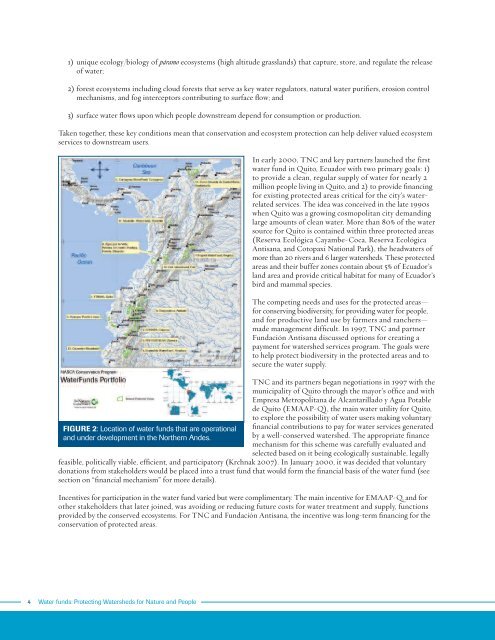Water Funds - Natural Capital Project
Water Funds - Natural Capital Project
Water Funds - Natural Capital Project
- No tags were found...
Create successful ePaper yourself
Turn your PDF publications into a flip-book with our unique Google optimized e-Paper software.
1) unique ecology/biology of páramo ecosystems (high altitude grasslands) that capture, store, and regulate the releaseof water;2) forest ecosystems including cloud forests that serve as key water regulators, natural water purifiers, erosion controlmechanisms, and fog interceptors contributing to surface flow; and3) surface water flows upon which people downstream depend for consumption or production.Taken together, these key conditions mean that conservation and ecosystem protection can help deliver valued ecosystemservices to downstream users.FIGURE 2: Location of water funds that are operationaland under development in the Northern Andes.In early 2000, TNC and key partners launched the firstwater fund in Quito, Ecuador with two primary goals: 1)to provide a clean, regular supply of water for nearly 2million people living in Quito, and 2) to provide financingfor existing protected areas critical for the city’s waterrelatedservices. The idea was conceived in the late 1990swhen Quito was a growing cosmopolitan city demandinglarge amounts of clean water. More than 80% of the watersource for Quito is contained within three protected areas(Reserva Ecológica Cayambe-Coca, Reserva EcológicaAntisana, and Cotopaxi National Park), the headwaters ofmore than 20 rivers and 6 larger watersheds. These protectedareas and their buffer zones contain about 5% of Ecuador’sland area and provide critical habitat for many of Ecuador’sbird and mammal species.The competing needs and uses for the protected areas—for conserving biodiversity, for providing water for people,and for productive land use by farmers and ranchers—made management difficult. In 1997, TNC and partnerFundación Antisana discussed options for creating apayment for watershed services program. The goals wereto help protect biodiversity in the protected areas and tosecure the water supply.TNC and its partners began negotiations in 1997 with themunicipality of Quito through the mayor’s office and withEmpresa Metropolitana de Alcantarillado y Agua Potablede Quito (EMAAP-Q), the main water utility for Quito,to explore the possibility of water users making voluntaryfinancial contributions to pay for water services generatedby a well-conserved watershed. The appropriate financemechanism for this scheme was carefully evaluated andselected based on it being ecologically sustainable, legallyfeasible, politically viable, efficient, and participatory (Krchnak 2007). In January 2000, it was decided that voluntarydonations from stakeholders would be placed into a trust fund that would form the financial basis of the water fund (seesection on “financial mechanism” for more details).Incentives for participation in the water fund varied but were complimentary. The main incentive for EMAAP-Q, and forother stakeholders that later joined, was avoiding or reducing future costs for water treatment and supply, functionsprovided by the conserved ecosystems. For TNC and Fundación Antisana, the incentive was long-term financing for theconservation of protected areas.4 <strong>Water</strong> funds: Protecting <strong>Water</strong>sheds for Nature and People
















